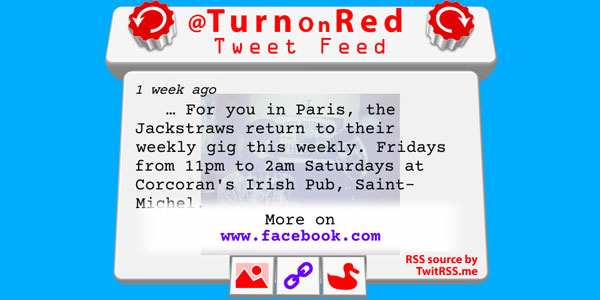
I just published a new Frogans site at frogans*TurnOnRed.
It shows how you can publish a Twitter stream on a Frogans site. This one displays my tweets, one tweet per slide (using my handle @turnonred).
In a nutshell, it retrieves an RSS feed for “@turnonred” using PHP and the service at TwitRSS.me.
You can click on the knobs at the top to browse through older or more recent tweets. Once you get to the 20th tweet, hitting the right knob takes you back to the most recent tweet. Likewise, if you’re viewing the most recent tweet and you hit the left knob, it takes you to the 20th most recent tweet.
There are also three buttons centered at the bottom:
- if the tweet contains an image, then the button on the lower left displays the image included in the tweet (with a link to view the image in a web browser),
- if the tweet contains a link to a web page, then the button in the middle links to that page, and
- the button on the lower right links to that same tweet, but at twitter.com.
The button on the far lower right gives credit to TwitRSS.me and links to the service’s website. TwitRSS.me fetches Twitter user timelines (and searches also) and displays the results as RSS feeds. RSS feed results can be published in FSDL with PHP using the DOMDocument class.
Publish your own
So you wanna publish your own Twitter feed on a Frogans site?
- First, download the ZIP archive of this Frogans site.
- Create new background image files to suit your personality.
- Insert your own Twitter handle (or the one that you would like to use) into “home.php”.

- Upload all of this to a PHP-enabled server and use it as your Frogans Site Root Directory. Read about Going Live with your Frogans address for more info.
Expect the site to run a little slow at first. This is because of the time that it takes to retrieve any images from Twitter, resize them and write them to a local folder (“tw-img”). This is only done once for each image, but it’s necessary because FSDL will only allow for access to locally-stored image resource files.
Questions? Please leave a comment, or contact me here.

Leave a Reply